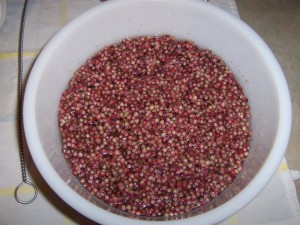Blackberries are up at this time of year, so of course a blackberry mead is in order. I made a few modifications to my Standard Mead Recipe. I used chaga tea as a base, which has almost become the norm for me at this point.
I blended a quart of wild blackberries, most of which were given to me by a friend, though I added about a cup from our yard, and strained out the seeds. I poured the blackberry puree into the must with the chaga tea and the honey.
In general, my quest is to use the highest quality, yet local, ingredients wherever possible. Up until now I have been using black tea and citrus fruits (oranges/lemons) to provide the citric acid and tannic acid desired by the yeast. Neither of these grow in my local ecosystem, and that has troubled me a bit. I wanted to take things to the next level here, and find a way to make it work without these imported ingredients.
However, Staghorn Sumac (Rhus typhina) does grow in my area, and it contains both citric acid as well as tannic acid. Some friends of mine tried using sumac in their meads and it seemed to go well (started bubbling within 24 hours) so I thought I’d give it a try with this batch as well. You don’t want the sumac to get too hot, so I poured warm (maybe 120 degrees) water over it and let it steep for a few minutes:
I then poured this tea, unstrained, into the carboy with the yeast, and the must came behind it, when I topped it off to 3-gallons. The result is the darkest color mead yet:
I’m anxious to see how it goes with the sumac rather than the tea/lemons. It started bubbling away within 8 hours and is going strong now. I really hope the results are good, because now literally every ingredient in this mead, except for the yeast, is local: spring water I harvested myself; local honey from Tony’s Honey in Buckfield, Maine; wild-harvested blackberries, chaga, and sumac.
The next step, and it will happen soon, is to start experimenting with wild yeast.
UPDATE: Here’s the label I made for this batch, with the new logo:



